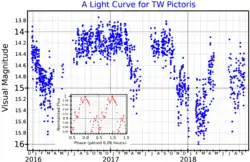 A light curve for TW Pictoris. The main plot,adapted from Scaringi et al. (2021),[1] shows the long-term visual band variation, and the inset plot, adapted from Patterson and Moulden (1993),[2] shows the periodic variability. | |
| Observation data Epoch J2000 Equinox J2000 | |
|---|---|
| Constellation | Pictor |
| Right ascension | 05h 34m 50.586s[3] |
| Declination | −58° 01′ 40.77″[3] |
| Apparent magnitude (V) | 15.10[4] (14.1 - 15.6)[5] |
| Characteristics | |
| U−B color index | 0.99[4] |
| B−V color index | 0.27[4] |
| Variable type | Nova-like variable[6] |
| Astrometry | |
| Proper motion (μ) | RA: −11.632 mas/yr[3] Dec.: 3.745 mas/yr[3] |
| Parallax (π) | 2.2839 ± 0.0223 mas[3] |
| Distance | 1,430 ± 10 ly (438 ± 4 pc) |
| Other designations | |
| Database references | |
| SIMBAD | data |
TW Pictoris is a 14th magnitude cataclysmic variable star system in the southern constellation of Pictor. It is located at a distance of approximately 1,430 light-years based on parallax measurements. Photometric observations in the visual band suggest a binary system with an orbital period of 6.06 hours.[8] One of the components is an accreting white dwarf.[1]
The X-ray source H0534-581 was identified from the data collected by the HEAO 1 satellite in 1979. In 1984, a candidate optical counterpart was identified by I. R. Tuohy and associates from photographs taken at the Schmidt telescope. A low-resolution spectrum revealed this is a cataclysmic variable, and it was assigned the variable star designation TW Pictoris. It was initially proposed to be an intermediate polar,[9][10] but the lack of an X-ray pulsation makes this less likely.[11] The current classification remains controversial.[1]
References
- 1 2 3 Scaringi, S.; et al. (October 2021). "An accreting white dwarf displaying fast transitional mode switching". Nature Astronomy. 6: 98–102. arXiv:2110.09124. Bibcode:2022NatAs...6...98S. doi:10.1038/s41550-021-01494-x. S2CID 239015940.
- ↑ Patterson, Joseph; Moulden, Margaret (July 1993). "Rapid Oscillations in Cataclysmic Variables. X. TW Pictoris (= H0534-581)". Publications of the Astronomical Society of the Pacific. 105: 779–784. Bibcode:1993PASP..105..779P. doi:10.1086/133229. S2CID 122934884.
- 1 2 3 4 5 Brown, A. G. A.; et al. (Gaia collaboration) (August 2018). "Gaia Data Release 2: Summary of the contents and survey properties". Astronomy & Astrophysics. 616. A1. arXiv:1804.09365. Bibcode:2018A&A...616A...1G. doi:10.1051/0004-6361/201833051. Gaia DR2 record for this source at VizieR.
- 1 2 3 O'Donoghue, D.; et al. (May 2013). "The Edinburgh-Cape Blue Object Survey - III. Zone 2; galactic latitudes -30° > b > -40°". Monthly Notices of the Royal Astronomical Society. 431 (1): 240–251. Bibcode:2013MNRAS.431..240O. doi:10.1093/mnras/stt158.
- ↑ Watson, Christopher (4 January 2010). "TW Pictoris". AAVSO Website. American Association of Variable Star Observers. Retrieved 28 July 2014.
- ↑ Samus, N. N.; et al. (2017). "General Catalogue of Variable Stars". Astronomy Reports. 5.1. 61 (1): 80–88. Bibcode:2017ARep...61...80S. doi:10.1134/S1063772917010085. S2CID 125853869. Retrieved 2021-11-27.
- ↑ "TW Pic". SIMBAD. Centre de données astronomiques de Strasbourg. Retrieved 2021-11-27.
- ↑ Balman, S.; et al. (June 2016). XMM-Newton Observations of TW PIC in comparison with the Archival SWIFT and RXTE data. XMM-Newton: The Next Decade, Proceedings of the Conference held 9-11 May, 2016 at ESAC, Madrid. Bibcode:2016xnnd.confE..73B. 73.
- ↑ Tuohy, I. R.; et al. (December 1986). "Identification of two southern X-ray emitting cataclysmic variables". Astrophysical Journal. 311: 275–298. Bibcode:1986ApJ...311..275T. doi:10.1086/164770.
- ↑ Mouchet, M.; et al. (October 1991). "The UV variability of the intermediate polars TW Pictoris (H 0534-581) and TX Columbae (1H 0542-407)". Astronomy and Astrophysics. 250: 99. Bibcode:1991A&A...250...99M.
- ↑ Norton, A. J.; et al. (February 2000). "The nature of TW Pictoris". Monthly Notices of the Royal Astronomical Society. 312 (2): 362–370. Bibcode:2000MNRAS.312..362N. doi:10.1046/j.1365-8711.2000.03216.x.